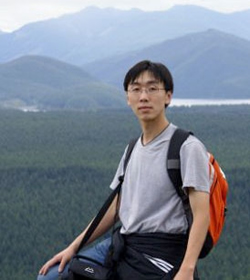|
Postdoctoral Associate Office: 226 Mason Lab Phone: (203) 436-4059 |
Since November 2012, Postdoctoral Associate, Yale University, School of Engineering & Applied Science, Department of Chemical Engineering August 2012, Ph.D. in Materials Science and Engineering, University of Washington, Seattle |
|
My current research is focused on two aspects: 1. Fabrication and characterization of organic/inorganic hybrid solar cell based on premade inorganic nano structures. |
|
Figure 1. Illustration of (a) device structure and (b) I-V characteristics of an organic/inorganic hybrid solar cell based on ZnO nano-rod forest |
|
Generally speaking, the efficiency of an organic/inorganic hybrid solar cell is defined by the product of absorption efficiency(ηA), exciton diffusion efficiency (ηED), charge separation efficiency (ηCS) and charge collection efficiency (ηCC). A premade nano structure, for example an ordered ZnO nano-rod forest can significantly increase the surface area between the organic and inorganic components, facilitate charge transport, while suppress radiative decay of excitons. Ideally that will result in increased ηCS and ηCC and ultimately better solar cell performance. However, that requires very carefully engineered process to optimize the morphology, interface, and compatibility between all the inorganic and organic components. My research is focused on developing such a process method using surface modification and multiple device engineering techniques, based on comprehensive characterization of the properties of related materials and devices. 2. Novel application of pyroelectric crystals/thin films for energy harvesting and etc. |
|
Figure 2. Illustration of the pyroelectric effect. |
|
| Pyroelectric materials can develop surface charges and generate high electric fields through modest change of temperatures. Field emission from pyroelectric crystals can also create high-energy (>100 keV) charged particles, yielding cheap and compact sources for x-rays, electrons, ions, and neutrons. However, these processes are transient in nature, which involve multiple time-varying parameters of the pyroelectric materials and their interacting substances. My research is focused on how to utilize this transient effect to harvest energy ideally from a continuous input of solar illumination. | |
My Ph.D. work was focused on advanced processing methods to introduce and preserve dipole orientation in organic electro-optic materials for next generation photonic devices. 1. Developed the first platform to efficiently pole electro-optic polymers using pyroelectric effect instead of conventional power source. 2. Demonstrated the first successful poling of nanoslot waveguide device using pyroelectric crystals, which opens the possibility to simultaneously activate thousands of nano EO devices on a silicon chip in one process. 3. First to explain the importance of the space charge effect in the EO polymer studies. Develop the first example to use a TiO2 barrier layer to suppress the space charge accumulation, which significantly improved the poling efficiency of many highly polarizable EO polymers. 4. Optimized the process conditions of EO polymers in a variety of novel photonic devices, including high speed modulators, terahertz generators, electromagnetic wave detectors and on-chip optical interconnects. |
|
|
|
|
|
|


